1996 PONTIAC GRAND-AM tires
[x] Cancel search: tiresPage 262 of 356
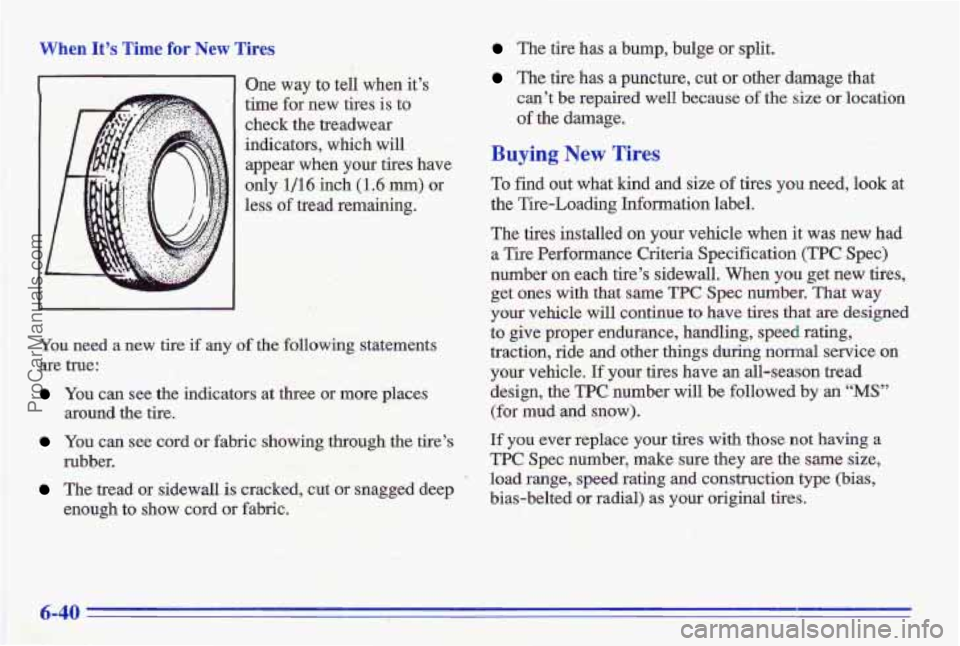
When It’s Time for New Tires
I One wav to tell when it’s
time
fcinew tiies is to
check the treadwear
indicators, which will
,.
appear when your tires have
only 1/16 inch (1.6 rrim) or
less
of tread remaining.
I
You need a new tire if any of the following statements
are true:
, 1, .” ! , .
You cdsee the indicators at three or more places
.. .. . . (. , ;.--.-$ _. . .I :: , L. -. , &&&
-. .. . .I , .I 1 -
around the tire.
You can see cord or fabric showing through the tire’s
The tread or sidewall is cracked, cut or snagged deep
rubber.
enough to
show cord or fabric.
The tire has a bump, bulge or split.
The tire h’as a puncture, cut or other damage that
can’t be repaired
well because of the size or lo’cation
of the damage.
Buying New Tires
To find out what kind and size of tires you need, look at
the Tire-Loading Information label.
The
tires installed on your vehicle when it was new had
a Tire Performance Criteria Specification (TPC Spec)
number
on each tire’s sidewall. When you get new tires,
get ones with that same
TPC Spec number. That way
your vehicle will continue to have tires that are designed
to give proper endurance, handling, speed rating,
traction, ride
and other thing’s during normal service on
your vehicle. If your tires have an all-season tread
design, the
TPC number will be followed by an “MS”
(for mud and snow).
If you ever replace your tires with those not having a
TPC Spec nuhber, make sure they are the same size,
load
range, speed rating &d construction type (bias,
bias-belted
or radial) as your original tires.
..
6-40
ProCarManuals.com
Page 263 of 356
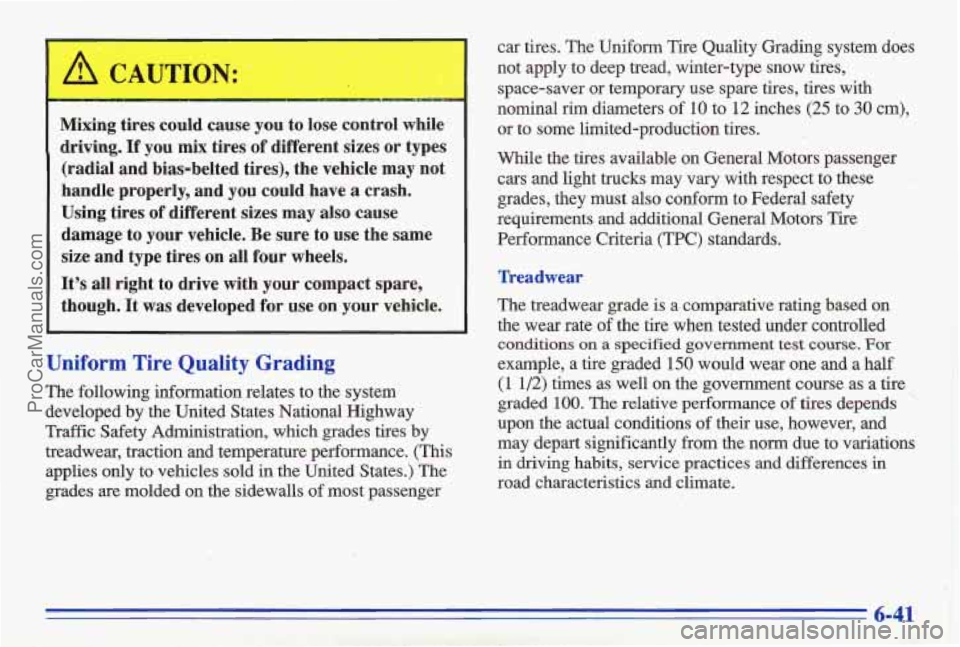
Mixing tires could cause you to lose control while
driving. If you mix tires of different sizes or types
(radial and bias-belted tires), the vehicle may not
handle properly, and you could.have
a crash.
Using tires of different sizes may also cause
damage to your vehicle. Be sure to use the same
size and type tires on all four wheels.
It's all right to drive with your compact spare,
though. It was developed for use on your vehicle.
Uniform Tire Quality Grading
The following information relates to the system
developed by the United States National Highway
Traffic Safety Administration, which grades tires by
treadwear, traction and temperature performance. (This applies only to'vehicles sold in the United States.)
The
grades are molded on the sidewalls of most passenger car tires. The Uniform Tire Quality Grading system does
not apply to deep tread, winter-type snow tires,
space-saver or temporqy use spare tires, tires with
nominal rim diameters of
10 to 12 inches (25 to 30 cm),
or to some limited-production tires.
While the tires available on General Motors passenger cars and light trucks may vary with respect to these
grades, they must also conform to Federal safety
requirements and additional General Motors Tire
Performance Criteria (TPC) standards.
Treadwear
The treadwear grade is a comparative rating based on
the wear rate
of the tire when tested under controlled
conditions on a specified government test course. For
example, a tire graded 150 would wear one and a half
(1 1/2) times as well on the government course as a tire
graded
100. The relative performance of'tires depends "
upon the actual conditions of their use, however, and
may depart significantly from the norm due to variations
in driving habits, service practices and differences in
road characteristics and climate.
ProCarManuals.com
Page 264 of 356
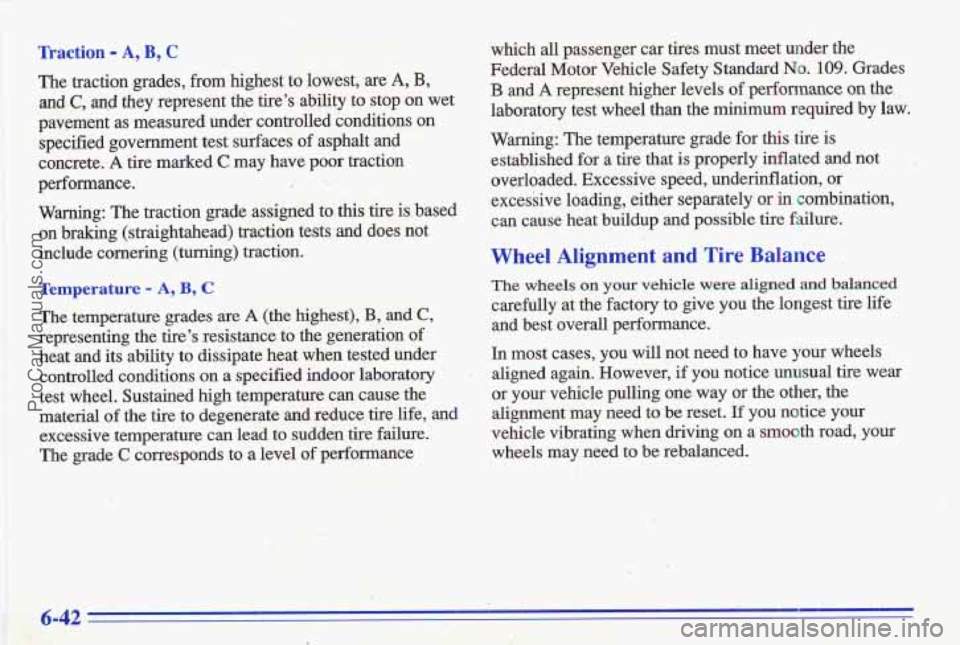
Traction - A, B, C
The traction grades, from highest to lowest, are A, B,
and C, and they represent the tire's ability to stop on wet
pavement as measured under controlled conditions on specified government test surfaces of asphalt and
concrete.
A tire marked C may have poor traction
performance.
Warning: The traction grade assigned to this tire is based
on braking'(straightahead) traction tests
and does not
include cornering (turning) traction.
Temperature - A, B, C
The temperature grades are A (the highest), B, and C,
representing the tire's resistance to the generation of
heat and its ability to dissipate heat when tested under
controlled conditions on a specified indoor laboratory
test wheel. Sustained high temperature
can cause the
material
of the tire to degenerate and reduce tire life, and
excessive temperature can lead to sudden tire failure.
The grade
C corresponds to a level af performance which all passenger
car tires must meet under the
Federal Motor Vehicle Safety Standard
No. 109. Grades
€3 and A represent higher levels of performance on the
laboratory test wheel than
the minimum required by law.
Warning: The temperature gade for this tire is
established for a tire that is properly inflated and not
overloaded. Excessive speed, underinflation, or
excessive loading, either separately or
in combination,
can cause heat buildup and possible tire failure.
Wheel Alignment and Tire Balance
The wheels osn your vehicle were aligned and balanced
carefully at the factory to give you the lo'ngest tire life and best overall performance.
In most cases, you..will not need to have your wheels
aligned again. However,
if you notice unusual tire wear
or your vehicle pulling one way or the other, the
alignment may need to be reset.
If you notice your
vehicle vibrating when
driving on a smooth road, your
wheels may need to be rebalanced.
ProCarManuals.com
Page 265 of 356
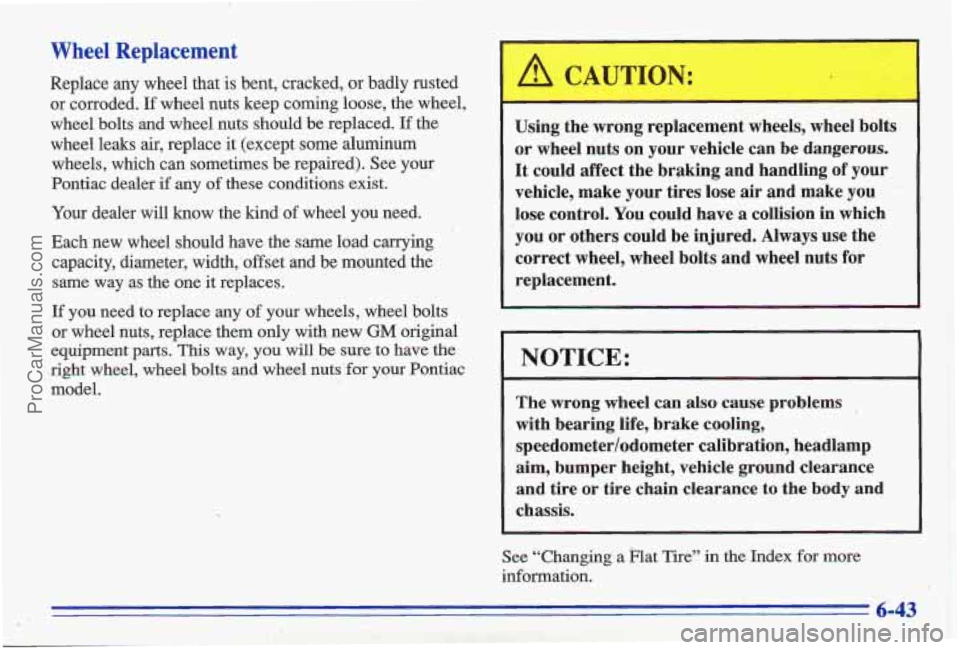
Wheel Replacement
Replace any wheel that is bent, cracked, or badly rusted
or co’rroded.
If wheel nuts keep coming loose, the wheel,
wheel bolts and wheel nuts should be replaced.
If the
wheel leaks air, replace it (except some aluminum
wheels, which can sometimes be repaired). See your
Pontiac dealer if any
of these conditions exist.
Your dealer will know the kind
of wheel you need.
Each new wheel should have the she load carrying
capacity, diameter, width, offset and be mounted the
same way as the one it replaces.
If you need to replace any of your wheels, wheel bolts
or wheel nuts, replace them only with new
GM original
equipment
parts. This way, you will be sure to have the
right wheel, wheel bolts
and wheel nuts for your Pontiac
model.
A CAUTION:
Using the wrong replacement wheels, wheel bolts
or wheel nuts on your vehicle can be dangerous.
It could affect the braking and handling
of your
vehicle, make your tires lose air and make you
lose control. You could have
a collision in which
you
or others could be injured. Always use the
correct wheel, wheel bolts and wheel nuts
for
replacement.
NOTICE:
The wrong wheel can also cause problems
with bearing life, brake cooling,
speedometer/odometer calibration, headlamp
aim, bumper height, vehicle grou.nd clearance
and tire
or tire chain clearance to the body and
chassis.
See “Changing a plat Tire” in the Index for more
information.
6-43
ProCarManuals.com
Page 266 of 356
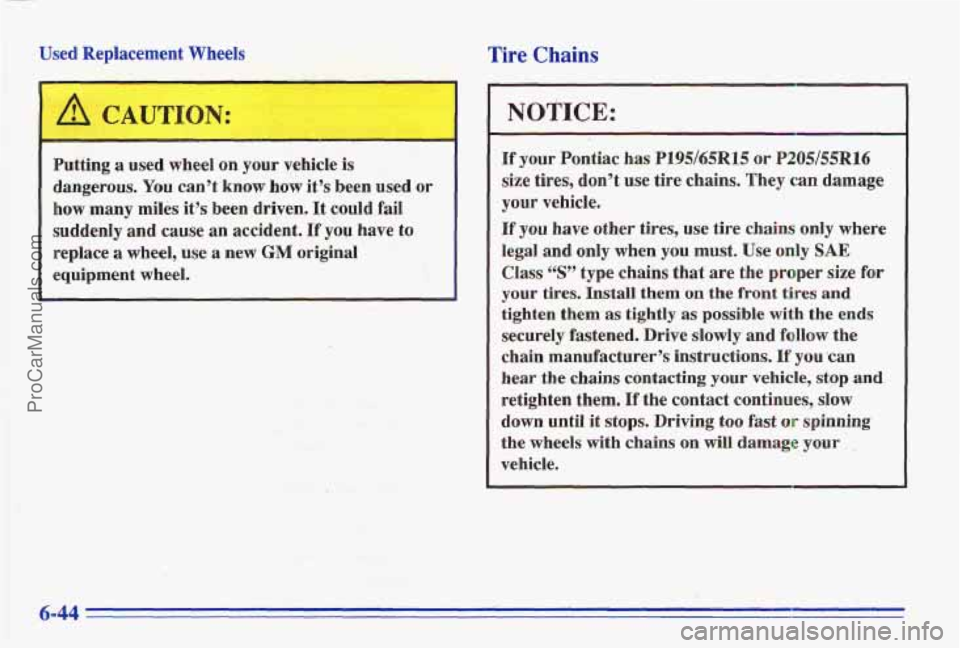
Used Replacement Wheels Tire Chains
A CAUTION:
Putting a used wheel on your vehicle is
dangerous.
You can’t know how it’s been used or
how many miles it’s been driven. It could fail
suddenly and cause an accident.
If you have to
replace
a wheel, use a new GM original
equipment wheel.
NOTICE:
If your Pontiac has P195/65R15 or P205/55R16
size tires, don’t use tire chains. They can damage
your vehicle.
If you have other tires, use tire chains only where
legal and only when you
must. Use only SAE
Class “S” type chains that are the proper size for
your tires. Install them on the front tires and
tighten them as tightly as possible with the ends
securely fastened. Drive slowly and follow the
chain manufacturer’s instructions.
If you ’can
hear the chains contacting your vehicle, stop and
retighten them.
If the contact continues, slow
down until it stops. Driving
too fast or spinning
the wheels
with chains on will damage your
vehicle.
6-44
ProCarManuals.com
Page 272 of 356
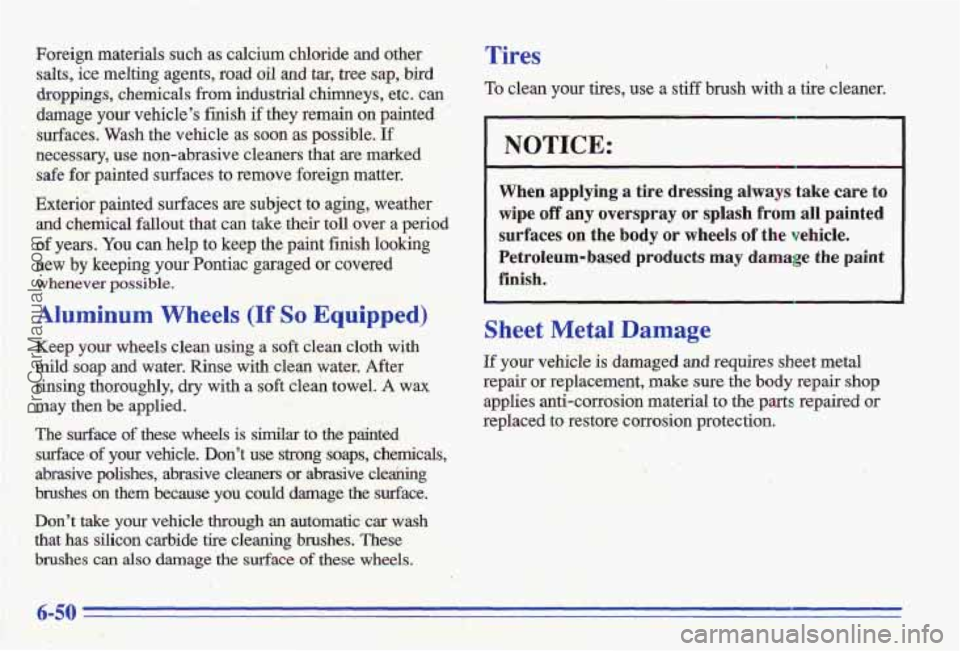
Foreign materials such as calcium chloride and other Tires
salts, ice melting agents, road oil and tar, tree sap, bird
droppings, chemicals from industrial chimneys, etc. can To clean your tires, use a stiff brush with a tire cleaner. -- -
damage your vehicle's finish if they remain on painted
surfaces. Wash the vehicle as soon as possible.
If
necessary, us,e non-abrasive cleaners that are marked safe
for painted surfaces to remove foreign matter.
Exterior pai
' :d surfaces are subject to aging, weath
and chemicsu rallout that caf; take their toll over a period
of yearg. You can help to keep the paint finish looking
new by keeping your Pontiac garaged or covered
whenever possible.
NOTICE:
''i
wipe off 'any overspray or splash from all painted
When applying a tire dressing always take care
to
surfaces
on the body or wheels of the vehicle.
Petroleum-based
products may damage the paint
finish.
Aluminum Wheels (If So Equipped)
I
Sheet Metal Damage
Keep your wheels clean using a soft clean cloth with
mild soap and water. Rinse with Clem water. After If your vehicle is damaged and requires sheet metal
rinsing thoroughly,
dry with a soft cleah towel. A wax repair or replacement, make sure the body repair shop
may then be applied. applies anti-corrosion material to the parts repaired or
The surface of these wheels is similar to the minted replaced to restore corrosion protection. A
surface.of your vehicle, Don't use strong soaps, chemicals,
abrasive
polishes, abrasive cleaners or abrasive clehg
brushes
on tihem because you could damage. the surface.
Don't
take your viihiclk through an automatic car wash
that has silicon carbide
tire cleaning brushes. These
brushes can also darnage the surface of these wheels.
6-50
ProCarManuals.com
Page 291 of 356
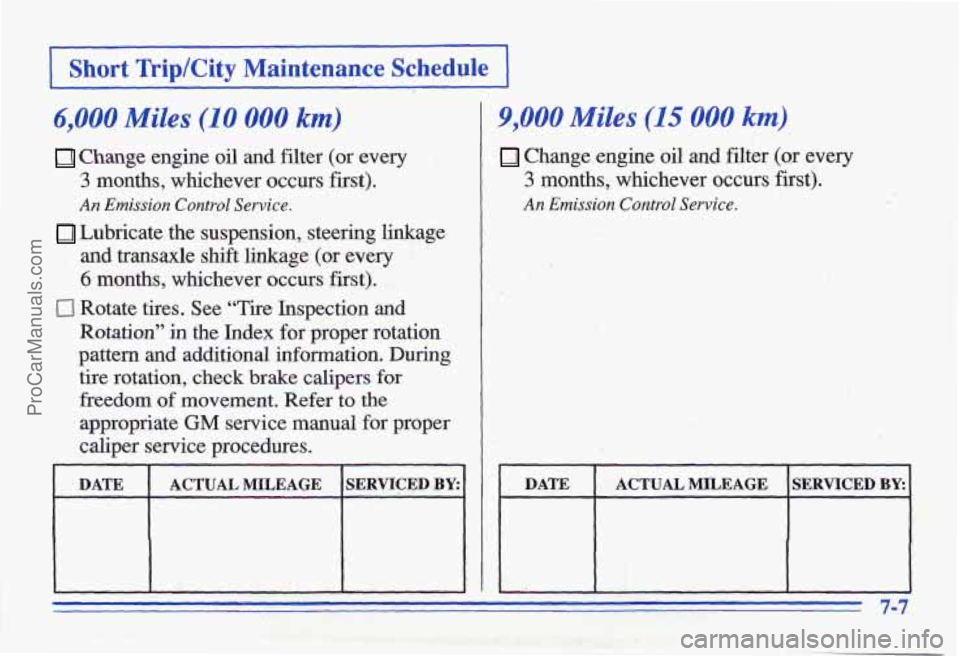
I Short Trip/City Maintenance Schedule I
6,000 Miles (10 000 km)
Change engine oil and filter (or every
3 months, whichever occurs first).
An Emission Control Service.
Lubricate the suspension, steering linkage
and transaxle shift linkage (or every
6 months, whichever occurs first).
0 Rotate tires. See “Tire Inspection and
Rotation” in the Index for propter rotation
pattern and additional information. During tire rotation, check brake calipers
for
freedom of movement. Refer to the
appropriate GM service manual for proper
caliper service procedures.
~
DATE SERVICED BY: ACTUAL MILEAGE
9,000 Miles (15 000 km)
Change engine oil and filter (ar every
3 months, whichever occurs first).
An Emission Control Service.
DATE ACTUAL MILEAGE SERVICED BY:
7-7
ProCarManuals.com
Page 293 of 356
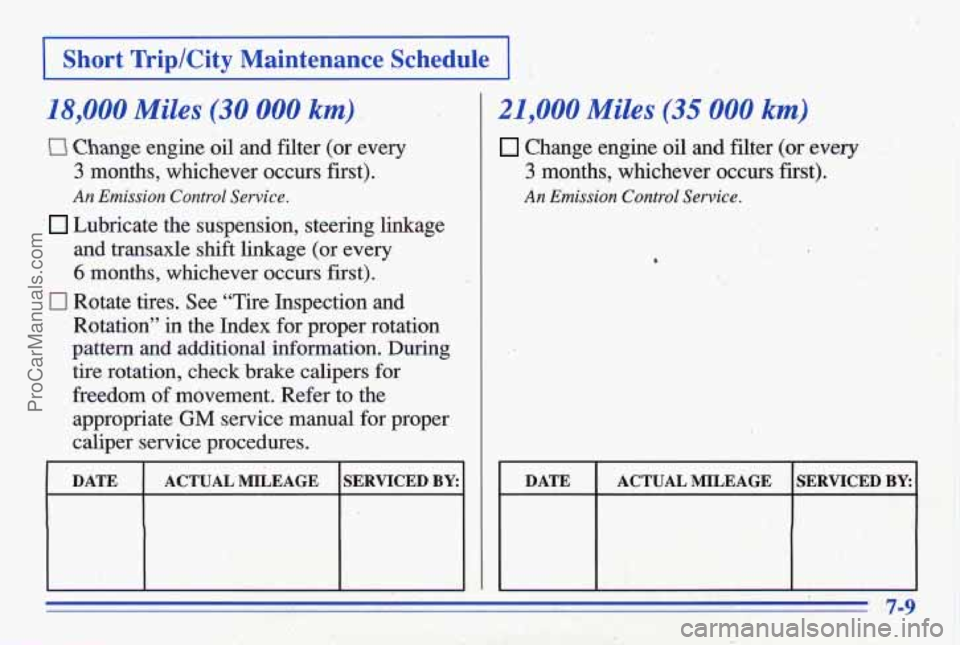
Short TriplCity Maintenance Schedule ,’
!
18,000’ Miles: (30 000 km) I :.
El Change engine oil and filter (or every
3 months, whichever occurs first).
An Emission Control Service.
Lubricate the suspension, steering linkage
and transaxle shift linkage (or every
6 months, whichever occurs first).
0 Rotate tires. See “Tire Inspection and
Rotation’’
in the Index for proper rotation
pattern and additional information. During
tire rotation, check brake calipers for
freedom of mdvement. Refer to the
appropriate
GM service manual for proper
caliper service procedures.
21,000 Miles (35 000 km)
Change engine oil and filter (or every
3 months, whichever occurs first).
An Emission Control Service.
8
I I I 1
DATE ACTUAL MILEAGE SERVICED BY:
ProCarManuals.com